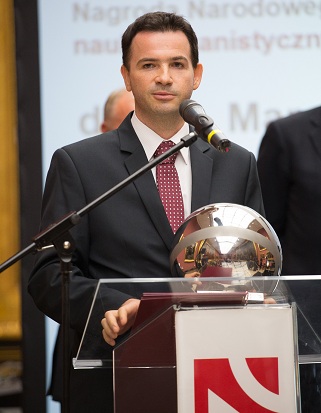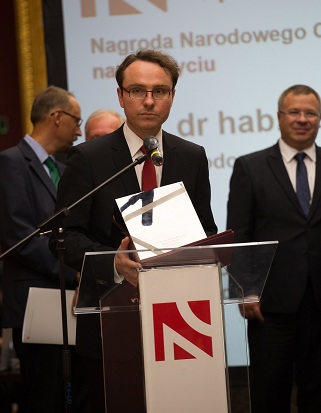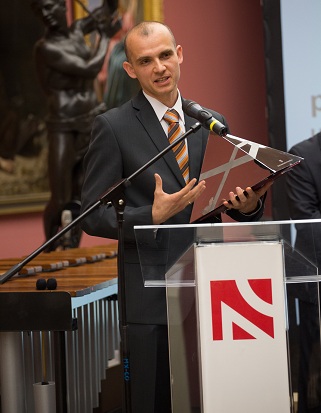NCN Award winner in Arts, Humanities and Social Sciences
Dr hab. Marcin Miłkowski, Prof. nadzw.; Institute of Philosophy and Sociology Polish Academy of Sciences
Scientific achievement: proposing an original computational version of the theory of mind and its defence in a monograph published by the prestigious MIT Press
Professor Marcin Miłkowski’s book, “Explaining the Computational Mind” (Cambridge Mass: The MIT Press, 2013), is a very ambitious monograph. Its purpose is to defend a computational model of the human mind and its explanatory potential. The author aims not so much to show that the model has an instrumental value (as computational models allow us to roughly describe and predict the behaviour of actual minds and design artificial systems that imitate mental operations) as to make an ontological argument that the mind is computational in its very essence. The book went through a very rigorous peer review procedure and was published by the most prestigious publisher in the field. It is an excellent example of how you can respect the monographic demands of the humanities and social science and yet make them genuinely international in scope. Miłkowski’s book met with great interest and applause inside the Polish and international community working in philosophy and cognitive science. It won the Tadeusz Kotarbiński Award, handed out by Division I: Humanities and Social Sciences, PAS, and a review of it was published in the renowned online journal, Notre Dame Philosophical Reviews. More reviews are either already in print or pending. The book is also already getting citations. Miłkowski ranks among the best Polish philosophers and cognitive scientists of the younger generation, with a very diverse and partly international research record. To learn more about his activity, visit his website: marcinmilkowski.pl..
NCN Award winner in Life Sciences
Prof. Dr hab. Janusz Bujnicki, International Institute of Molecular and Cell Biology in Warsaw
Scientific achievement:
- Creating new structural modelling tools
- Developing innovative bioinformatics methods for the study of protein-RNA complexes and discovering the structure and mechanism of action of human enzymes responsible for RNA biosynthesis
1. Janusz Bujnicki’s career started in experimental research, but most of his research record today is in bioinformatics. In particular, he is interested in the structure of proteins, including those that interact with nucleic acids. Professor Bujnicki founded a research school of his own in the field of the structural modelling of proteins. His original method of predicting protein structures in silico, known as the “Frankenstein monster” approach, has found wide-ranging applications in bioinformatics, and his students are already successful around the world. His papers on the subject have been mostly published in renowned, high-ranking international journals in the field of molecular biology, biochemistry and bioinformatics, such as “Nucleic Acids Research”, “Journal of Molecular Biology”, “Journal of Biological Chemistry”, “EMBO Reports” and “Bioinformatics”. He has completed projects funded from domestic and international sources, including prestigious EMBO and ERC grants.
2. He was nominated for the NCN Award for the development and application of bioinformatics methods which, combined with experimental techniques, helped to model the structure and function of human CMTr1 and CMTr2 proteins. A team led by Professor Bujnicki found that alongside the independently identified CMTr1 protein, the CMTr2 protein acts as an enzyme responsible for the methylation of one of the riboses on the 5ʹ-tail of mRNA, as well as some other RNAs, during cap biosynthesis in human cells. Cap methylation is indispensable for the proper functioning of human cells; it is also used by some viruses to mask their own RNA and avoid the non-specific immune response of human cells. Discovered by Professor Bujnicki and his team in cooperation with groups led by Professor Darżynkiewicz and Dr Nowotny, the structure of the catalytic domains of CMTr1 and CMTr2 in RNA-protein complexes helped explain how these proteins interact with the cap and identify differences in their cap-binding mechanism, as compared to analogous viruses. Bujnicki’s team answered a number of key questions in the field of RNA biogenesis and identified the role of the CMTr2 protein in cap biosynthesis and the mechanism behind the RNA cap recognition by human methyltransferases. They also explained how this process unfolds in humans on the one hand, and in viruses on the other, significantly expanding our knowledge about its impact on the functioning of human cells and human health. The discovery will also facilitate research on new anti-viral drugs. To enable all this, Bujnicki developed his own original methods for the computer-based prediction of the structure of RNA and protein-RNA complexes. His research results were presented in a series of 17 articles published between 2011-2013 (including 6 times in “Nucleic Acids Research”), and a final, prestigious article in “Nature Communications”. Research on RNA methyltransferases, including CMTr1 and CMTr2, will now continue under a new project selected by the Foundation for Polish Science in the MISTRZ programme.
NCN Award winner in Physical Sciences and Engineering
Prof. Dr hab. Michał Horodecki, Faculty of Mathematics, Physics and Informatics, University of Gdańsk
Scientific achievement: discovering bound-entanglement quantum states and studying the non-additivity of quantum capacity in quantum channels
Michał Horodecki is the author of many ground-breaking publications in the field of quantum information theory. His first well-known achievement was the discovery of bound-entangled quantum states that cannot be locally transposed into Bell’s maximally entangled states. The discovery has already been confirmed experimentally by two independent teams conducting optical experiments on the properties of correlated photons. In their experiments, the teams used an entanglement witness, a theoretical concept proposed and developed in cooperation with Michał Horodecki. His more recent achievements include an analysis of random circuit convergence to the Haar measure, a study of the spectral gap, a demonstration of the instability of Kitayev’s models of topological quantum memory, a simplification of Hastings’ proof of the non-additivity of quantum capacity in quantum channels and a constructive example of the non-additivity of Renyi’s minimal entropy. According to the ISI database, in 1994-2014, Michał Horodecki’s works were cited (at least) 85,000 times; he is the author or co-author of 19 works, each of which has been cited more than 100 times, and his current h-index equals at least 37. Few researchers of his generation can boast a similar impact factor. Professor Horodecki has conducted fruitful collaborative projects with top experts in quantum information theory and presented his research results as a guest lecturer in various countries all around the world. It would be well-nigh impossible to find a serious international physicist in the field of quantum information theory who has not heard about at least some of his work. Horodecki is one of the most outstanding Polish physicists of the young generation.



